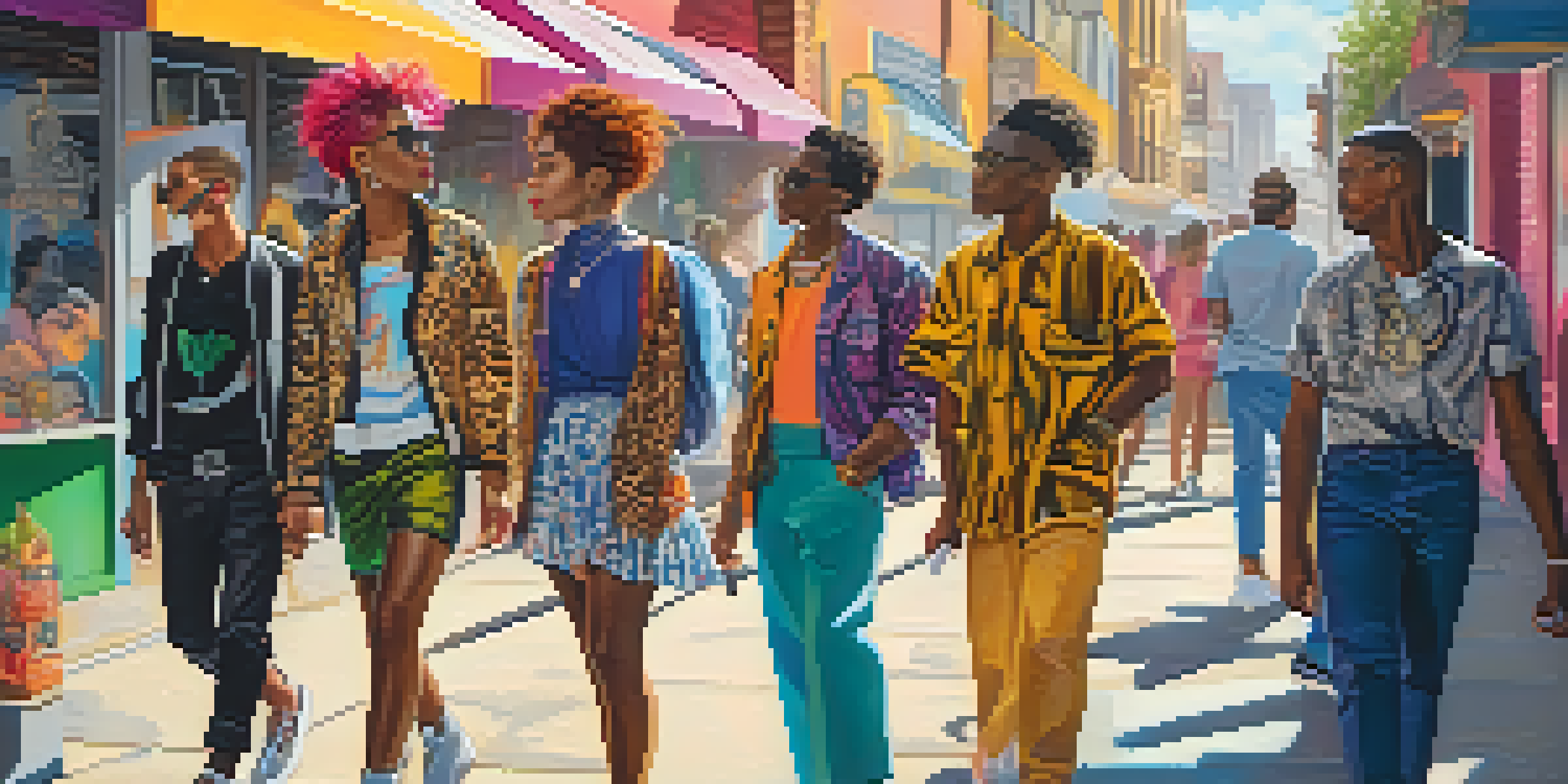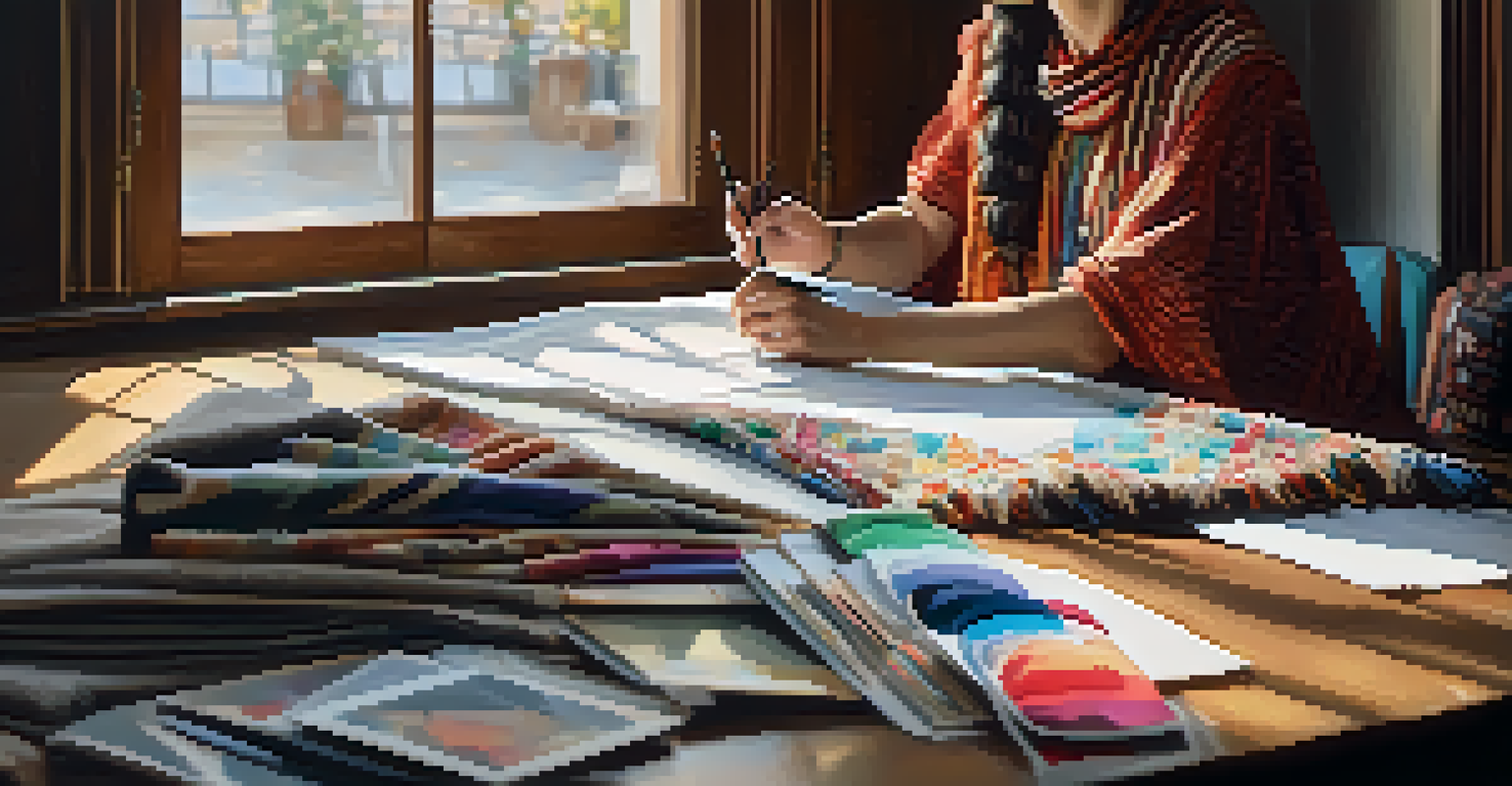The Intersection of Fashion, Gender, and Social Justice

Fashion as a Reflection of Gender Identity and Expression
Fashion has long served as a canvas for individuals to express their gender identity. From the bold choices of gender-fluid styles to the reclaiming of traditionally gendered attire, clothing can challenge societal norms and expectations. For instance, many people use fashion to signal their identity, often defying conventional labels.
Fashion is the armor to survive the reality of everyday life.
In recent years, we've witnessed a surge in discussions around non-binary and gender-neutral clothing lines. Brands like Telfar and Phlemuns have embraced this shift, offering options that cater to a diverse audience. This evolution in fashion not only empowers individuals but also fosters a broader acceptance of varied gender identities.
Ultimately, fashion's ability to reflect and shape gender identity underscores its importance in today’s social landscape. As individuals seek to express themselves authentically, they are also challenging outdated norms, paving the way for more inclusive representations in society.
Historical Context: Fashion's Role in Social Movements
Fashion has always been intertwined with social movements, acting as both a tool and a symbol for change. From the suffragette movement, where women wore white dresses to signify purity and purpose, to the Black Panther Party's iconic leather jackets, clothing has played a significant role in advocating for rights. These examples show how attire can unite people and convey powerful messages.

In the 1980s, the AIDS crisis catalyzed a wave of activism that influenced fashion, leading to the emergence of bold colors and statements in clothing as a form of protest. Designers began to use their platforms to raise awareness, creating pieces that not only showcased talent but also sent poignant messages regarding health and human rights.
Fashion Reflects Gender Identity
Fashion serves as a powerful means for individuals to express their gender identity and challenge societal norms.
Today, the connection between fashion and social justice remains strong as movements like Black Lives Matter and climate activism inspire new trends. Designers are increasingly using their collections to reflect their values, emphasizing that fashion is not just about aesthetics but also about standing up for what is right.
Consumer Activism: The Power of Ethical Fashion Choices
In today’s world, consumers are more conscious than ever about the impact of their purchases. Ethical fashion, which prioritizes sustainability and fair labor practices, has gained traction as people seek to support brands that align with their values. This shift toward conscious consumerism is reshaping the industry, encouraging brands to be more transparent.
Style is a way to say who you are without having to speak.
For example, brands like Everlane and Reformation have built their reputations on ethical practices, showcasing their commitment to social justice through their business models. By providing information about their supply chains, they empower consumers to make informed choices that reflect their ethical beliefs.
As consumers wield their purchasing power, they are sending a clear message to the fashion industry: they demand accountability and responsibility. This collective activism is vital in driving brands to adopt more equitable practices, ultimately reshaping the landscape of fashion for the better.
Cultural Appropriation vs. Cultural Appreciation in Fashion
The conversation around cultural appropriation versus cultural appreciation is particularly relevant in fashion today. Many designers draw inspiration from diverse cultures, but when this is done without understanding or respect, it can lead to problematic representations. This often results in a lack of acknowledgment for the origins of certain styles and the communities that created them.
For instance, when Western designers incorporate traditional garments from other cultures without permission or recognition, it can dilute their significance. This raises questions about ownership and respect, prompting calls for more inclusive practices that honor the roots of various fashion elements.
Fashion as a Tool for Social Change
Throughout history, fashion has played a significant role in social movements, uniting people and conveying powerful messages.
To navigate this complex terrain, the fashion industry is beginning to emphasize collaboration with cultural communities. By fostering genuine partnerships, designers can create pieces that celebrate cultural heritage while ensuring that those communities receive recognition and respect for their contributions.
The Influence of Social Media on Fashion and Activism
Social media has revolutionized the way we perceive and engage with fashion, providing a platform for voices that were previously marginalized. Influencers and activists alike use platforms like Instagram and TikTok to spread awareness about social justice issues, often using their fashion choices to make statements. This has democratized fashion, allowing anyone to participate in the conversation.
For example, movements like #BlackandProud and #FashionForAll have gained traction, encouraging individuals to share their stories and styles while advocating for change. This visibility not only amplifies diverse voices but also challenges the industry's status quo, pushing for more inclusivity.
Moreover, social media allows for real-time dialogue between consumers and brands. As companies face scrutiny over their practices, they are increasingly held accountable by the online community, making transparency and authenticity more crucial than ever in the fashion world.
Future Trends: Fashion's Potential for Social Change
Looking ahead, the intersection of fashion, gender, and social justice presents exciting possibilities for change. As awareness continues to grow, we can expect more brands to prioritize inclusivity and sustainability in their designs. This shift not only meets consumer demand but also aligns with a broader movement toward social responsibility.
Innovations in technology, such as 3D printing and sustainable materials, offer opportunities for fashion to become more eco-friendly and accessible. Brands that embrace these advancements are likely to lead the charge in creating a more equitable industry, setting an example for others to follow.
Consumer Power Drives Ethical Fashion
Today's consumers are increasingly prioritizing ethical fashion choices, demanding accountability and sustainability from brands.
Ultimately, the future of fashion lies in its ability to adapt and respond to societal needs. By prioritizing social justice, the industry can foster a culture of acceptance, creativity, and responsibility, proving that style can indeed be a force for good.
Conclusion: Embracing Change in Fashion and Society
As we navigate the complex intersection of fashion, gender, and social justice, it's clear that change is not only possible but necessary. Fashion has the power to inspire, provoke thought, and unite individuals across diverse backgrounds. By embracing this potential, we can create a more inclusive and equitable society.
The ongoing dialogue around fashion and its implications for social justice reminds us that every choice we make—whether it’s what we wear or how we support brands—can contribute to larger movements for change. Each garment carries the weight of its story, and by being mindful of this, we can make informed decisions.

In conclusion, the intersection of fashion, gender, and social justice is a rich and evolving landscape. As we continue to challenge norms and advocate for equality, we must remember that fashion can be a powerful tool for positive change, both on the runway and beyond.